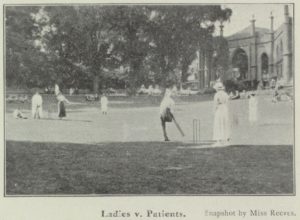From Western Front to Sea Front: The Pavilion “Blues”
This is a legacy story from an earlier version of our website. It may contain some formatting issues and broken links.
The first edition of The Pavilion “Blues” was published during June 1916. Researcher, Jo Palache, describes how the magazine reveals the experience of patients and staff at the Pavilion Military Hospital for limbless soldiers during the First World War.
Very few official records from the Pavilion Military Hospital for limbless soldiers survive. However, Brighton Museum has a complete set of the 45 editions of the hospital magazine, The Pavilion “Blues”, that was published monthly from June 1916 to February 1920.

The first edition of The Pavilion “Blues”, June 1914 © Royal Pavilion & Museums, Brighton & Hove
Named after the patients’ standard blue army uniforms, the magazine became my primary source of information while researching this neglected period of the Pavilion Estate’s history. Photographs, articles, cartoons, poems and event reports all provide clues as to how the buildings and grounds were used, the forms of treatment available and above all the attitudes and experiences of the patients themselves.
The positive outlook of the contributors helped the men to recover and face the challenges and discomforts during the long months of treatment. The articles often display the dry army humour, which had previously helped the soldiers through the horrors of trench warfare. One cartoon in particular reflects this by playing on the theme of the Western Front having been replaced by the Brighton Seafront.

The Pavilion “Blues”, May 1918. © Royal Pavilion & Museums, Brighton & Hove
The unknown artist states that his inspiration came from a more poignant sub-editorial in the previous month’s edition when Sergeant Penfold wrote:
[pullquote align=center]
The [Brighton] front is crowded with a mixed throng, all basking in the warmth. Folk are just beginning to cast off their fur coats and the heavy outer garments of Winter, and adorn themselves with a lighter and more varied shade of material.
A peaceful scene – broken only by the continued hum of an aeroplane which is flying above, and which reminds them of the other picture.
That is also of a front – but a vastly different one to the former. Promenade, composed of duck-boards and sand-bags; piers, more numerous, but in the form of listening posts; the same sun shining overhead, but nature robbed of its beauty by the hail of iron from the guns; only an occasional bird to be seen.
[/pullquote]
However, the magazine mainly concentrates on life at the hospital. It could take up to a year to complete the treatment and the magazine is full of reports as to how the men occupied their days. Accounts of outings, sporting fixtures and other entertainments fill many of the pages and reflect the amputee’s determination not to be held back by their disabilities. While reports of the facilities at the hospital and the expertise of the staff celebrate the high standard of medical treatment.

‘Ladies vs. patients’ cricket at the Pavilion Military Hospital, The Pavilion “Blues”, July 1917 © Royal Pavilion & Museums, Brighton & Hove
As the number of patients dwindled by 1920, the final copy was published in February 1920 with the same trench humour. Today The Pavilion “Blues” continue to provide insights into the lives of some of the 41,000 men who had one or more limbs amputated during the First World War. They also provide a lasting tribute to the spirit of the staff and patients of the Pavilion Military Hospital. All are available to be downloaded from the Royal Pavilion & Museums Image Store, free of charge.
Jo Palache, Oral History and Life History Researcher for Pavilion Blues: Disability and Identity
If you have any information on the Pavilion Military Hospital or would like to know more, please contact me at jo.palache@brighton-hove.gov.uk.
